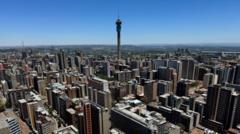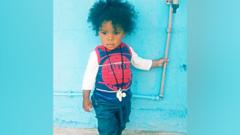This article explores the efforts taken in Johannesburg to revitalize the city, overcoming historical challenges, focusing on areas like Ponte Tower and Jewel City.
Revitalizing Johannesburg: Bridging Past Challenges with Future Aspirations

Revitalizing Johannesburg: Bridging Past Challenges with Future Aspirations
A look at how Johannesburg is transforming from a crime-ridden city to a beacon of hope and development.
Amidst the sprawling cityscape of Johannesburg, a remarkable transformation is taking place. Once notorious for its high crime rates and dilapidated buildings, Johannesburg is slowly regaining its stature as a vibrant urban center. A prominent symbol of this revival is Ponte Tower, which, though once a criminal hotspot, is now welcoming back residents and tourists alike.
Standing nearly 200 meters tall, Ponte Tower was built in 1975 and initially enjoyed its status as Africa's tallest residential building. However, during the 1980s, it fell prey to vandalism and was overrun by criminal elements, with its inner structure being filled with refuse and becoming a den for illicit activities. Delight Sithole, a guide operating tours of the building, recalls, “The building got hijacked. There were some dead bodies here, illegal firearms, drugs."
In the past, Johannesburg held a reputation as one of the world’s most dangerous cities. However, since the 2010 FIFA World Cup, a turning point for the city, the area has seen an influx of revitalization efforts. Recent trends indicate that the once-desolate Ponte Tower is now approximately three-quarters occupied, showcasing a significant recovery.
Yet challenges remain. Despite improvements in some crime statistics, Johannesburg still grapples with issues like intermittent power cuts and an emerging water crisis. A tragic incident in 2023, where nearly 80 lives were lost in a building fire, has highlighted the ongoing struggles against crime and the presence of hijacked buildings—properties taken over by gangs.
One entity attempting to reverse Johannesburg’s fortunes is Ithemba, a property development firm embracing the concept of hope (or "ithemba" in Zulu). The company has made impressive strides, currently leasing 7,200 properties, with plans to double that number within two years. Their flagship development, Jewel City, located in an area observing a resurgence, is indicative of the city's revival narrative.
The initiative aims not just to provide housing, but to reshape public perceptions of the Central Business District (CBD) as a safe and desirable location. Alan Tait, Ithemba’s senior manager, notes an unprecedented demand for living in the CBD, attributing the surge in residents to recovery efforts post-COVID.
The JoziMyJozi project represents a grassroots approach to urban renewal, focusing on enhancing safety and cleanliness around key city access points. Bea Swanepoel, the organization’s CEO, underscores the mission to restore hope: “By showcasing visible improvements, we can foster a spirit of resilience and solidarity among residents."
Looking ahead, Johannesburg is poised to host the G20 summit, opening up opportunities for investment and further development. As stakeholders work collectively toward a shared goal, the possibility of Johannesburg being recognized alongside cities like London and New York is no longer merely a distant dream; it is a tangible aspiration.
Standing on the 51st floor of Ponte Tower, Sifiso Zikhali of Dlala Nje reflects on the journey: “We are now one of the city's top attractions. This is our city, and whatever we face, we need at the end to find a solution for it." The ongoing revival of Johannesburg may well serve as a blueprint for urban regeneration across the continent.
Standing nearly 200 meters tall, Ponte Tower was built in 1975 and initially enjoyed its status as Africa's tallest residential building. However, during the 1980s, it fell prey to vandalism and was overrun by criminal elements, with its inner structure being filled with refuse and becoming a den for illicit activities. Delight Sithole, a guide operating tours of the building, recalls, “The building got hijacked. There were some dead bodies here, illegal firearms, drugs."
In the past, Johannesburg held a reputation as one of the world’s most dangerous cities. However, since the 2010 FIFA World Cup, a turning point for the city, the area has seen an influx of revitalization efforts. Recent trends indicate that the once-desolate Ponte Tower is now approximately three-quarters occupied, showcasing a significant recovery.
Yet challenges remain. Despite improvements in some crime statistics, Johannesburg still grapples with issues like intermittent power cuts and an emerging water crisis. A tragic incident in 2023, where nearly 80 lives were lost in a building fire, has highlighted the ongoing struggles against crime and the presence of hijacked buildings—properties taken over by gangs.
One entity attempting to reverse Johannesburg’s fortunes is Ithemba, a property development firm embracing the concept of hope (or "ithemba" in Zulu). The company has made impressive strides, currently leasing 7,200 properties, with plans to double that number within two years. Their flagship development, Jewel City, located in an area observing a resurgence, is indicative of the city's revival narrative.
The initiative aims not just to provide housing, but to reshape public perceptions of the Central Business District (CBD) as a safe and desirable location. Alan Tait, Ithemba’s senior manager, notes an unprecedented demand for living in the CBD, attributing the surge in residents to recovery efforts post-COVID.
The JoziMyJozi project represents a grassroots approach to urban renewal, focusing on enhancing safety and cleanliness around key city access points. Bea Swanepoel, the organization’s CEO, underscores the mission to restore hope: “By showcasing visible improvements, we can foster a spirit of resilience and solidarity among residents."
Looking ahead, Johannesburg is poised to host the G20 summit, opening up opportunities for investment and further development. As stakeholders work collectively toward a shared goal, the possibility of Johannesburg being recognized alongside cities like London and New York is no longer merely a distant dream; it is a tangible aspiration.
Standing on the 51st floor of Ponte Tower, Sifiso Zikhali of Dlala Nje reflects on the journey: “We are now one of the city's top attractions. This is our city, and whatever we face, we need at the end to find a solution for it." The ongoing revival of Johannesburg may well serve as a blueprint for urban regeneration across the continent.























